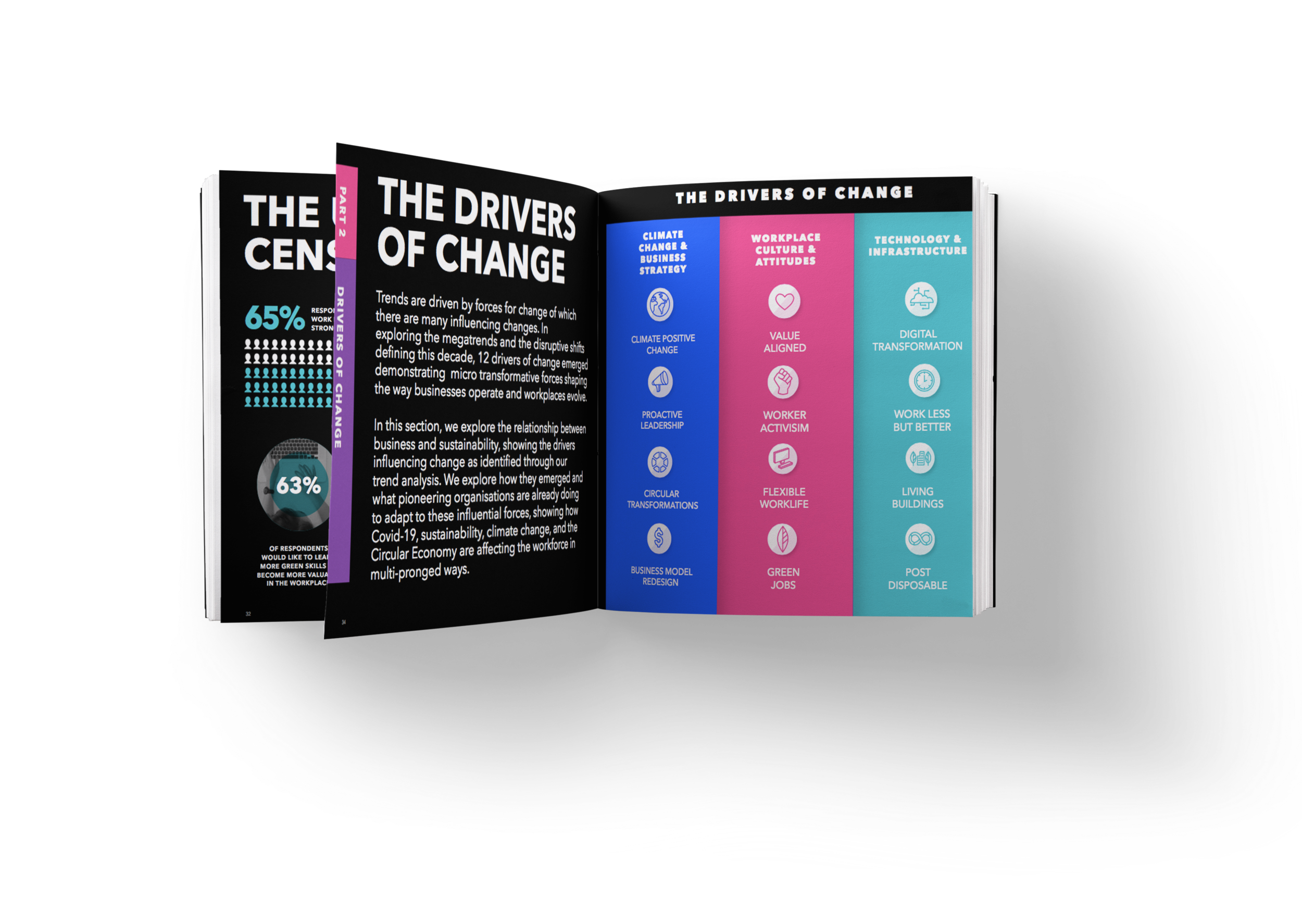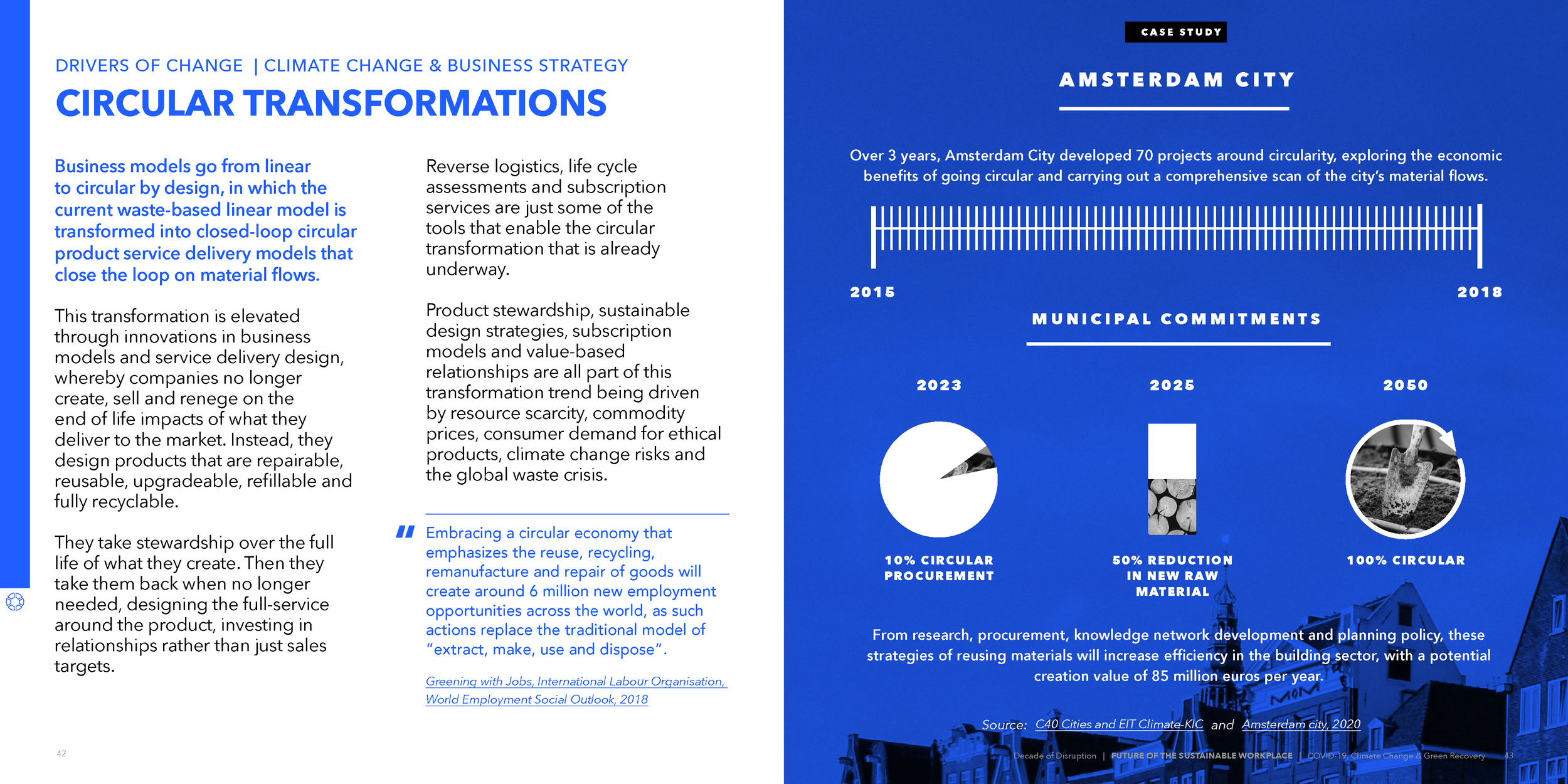What exactly makes 2020-2030 “the decade of disruption”? How are climate change and Covid-19 impacting workplace transformation and forcing adaptability to a sustainable future? What do businesses need to do in order to stay ahead of the curve and mitigate risk among this time of great and immediate change?
These are some of the questions we set out to answer in our groundbreaking report, Decade of Disruption: Future of the Sustainable Workplace in the Age of Covid-19 and Climate Change, written by Leyla Acaroglu and commissioned by Unily, which you can download in full here — it’s totally free!
Trends are driven by forces for change. While Part 1 of the report explored the megatrends and the disruptive shifts that will define this decade, there are many micro transformative forces shaping the way businesses operate and workplaces evolve.
Here in Part 2, we show the 12 Drivers of Change identified across three categories: Climate Change and Business Strategy; Workplace Culture and Attitudes; and Technology and Infrastructure.
Based on our trend analysis, we explore how they emerged and what some pioneering organizations are already doing to adapt to these influential forces, showing how sustainability, climate change, and the circular economy are affecting the workforce in multi-pronged ways.
If you want to join the ranks of these pioneering organizations and start your workplace sustainability journey, then take one of our Sustainability in Business Programs or week-long intensive happening in December.
Climate Change and Business Strategy
The need to create goods and services that are designed to have a positive effect on the environment, redesign business models that promote sustainability, and set new standards for business operations is critical to the success of organizations in this decade.
All levels of society are now demanding that companies take care of their impacts in some way. These demands are coming from workers, customers and governments. Every industry is being called to act in different ways, but overwhelming businesses need to, and in many cases already are acting on their social and environmental obligations.
“At its essence, sustainability means ensuring prosperity and environmental protection without compromising the ability of future generations to meet their needs. A sustainable world is one where people can escape poverty and enjoy decent work without harming the earth’s essential ecosystems and resources; where people can stay healthy and get the food and water they need; where everyone can access clean energy that doesn’t contribute to climate change” - Former UN Secretary-General Ban-Ki Moon
All aspects of business activities draw on many complex systems that, in turn, result in multi-level pollution back into the atmosphere and environment. From production and transport emissions in producing goods and delivering them to market, to the daily waste generated in office buildings, these are all contributing factors when we look at “doing work” and the effects this has on the climate crises.
Climate Positive Change
Driven by the global societal need to decarbonize the economy, organizations will adopt a diverse array of daily practices through to entire business operational transformation to move from carbon negative to carbon positive companies.
Proactive Leadership
The leaders of the past might have been ok with avoiding or even denying that action on environmental and social issues are important, but the leaders of the present and future are pioneering change within their organizations and reaping the benefits of this action.
Circular Transformations
Business models go from linear to circular by design. The current linear model of ‘take, make and waste’ is transformed into closed-loop circular product service delivery models that design out waste and design closed-loop material flows.
Business Model Redesign
Pivots toward mitigating costs due to changing structural, financial and environmental impacts, combined with maximizing new revenue streams and reduced employee and infrastructure costs offer more adaptive, flexible ways of conducting business in the face of change.
Workplace Culture and Attitudes
Work is a crucial part of our personal and cultural identity, purpose and wellbeing. It is also the lubrication of the economy, but with 77% of greenhouse gas emissions being directly attributed to industrial activities, electricity and transportation in the US, the impact of work on the climate and the wider natural systems we all need to survive is significant and workers are realizing this which in turn is affecting the culture within organizations.
Office buildings globally alone account for 28% of energy-related greenhouse gas emissions from all the heating and cooling, ventilation, lights and equipment needed to go about business and accommodate working humans. So the places and ways we engage in work are shifting to respond to driving forces around physical infrastructure, modes of getting to work, health and safety concerns along with lifestyle desires of the younger workforce.
We are seeing challenges to the old hierarchical models where younger workers are demanding ethical frameworks and holding their own employers accountable for their actions. All of these forces are altering the culture within organizations. Workers look for companies that have purpose and that value their employees; similarly, customers seek out companies that are aligned with their values and see workers being treated correctly. Unless organizations are willing to respond to this shift and embrace sustainability in all its forms as a core part of their operational DNA, then they will lose quality staff and suffer customer cynicism.
Value Aligned
Workers and customers are shifting their values and seeking out organizations that are value-aligned and meet their purpose-filled expectations, greater work-life balance when choosing a job and likeliness to work for a company with a strong sense of purpose and mission.
Worker Activism
There are increased demands from within the workforce for organisations to be relevant, ethical and aligned with the real-world changes that are occurring, be it responding to Covid-19, social equity or climate change. Employees are setting the agenda rather than the organization, as culture is shifting toward values and ethics being an equal player in profit and innovation.
Flexible Worklife
The demand for more work-life balance and the coinciding rise of telecommunication technologies with Covid-19 has accelerated the shift to diverse work-life scenarios customized to meet the employees’ and employers’ needs.
Green Jobs
As the economy changes, so will the types of jobs offered and skills needed by organizations to be competitive. Roles that encompass the skills, knowledge and capabilities to develop and advance a sustainable and resource-efficient world are on the rise, with demand increasing as changes to the workplace and business operations unfold.
Technology and Infrastructure
There is no doubt that technology is impacting all aspects of society in rapid ways, but the workplace is one area where tech-enabled change is being accelerated. Many executives are planning on redesigning their organizations to make them fit and ready for tomorrow, with many anticipating that technological transformation will continue to be a primary business disruptor (Global Trends 2020) .
Whilst tech is enabling rapid feedback of data to facilitate real-time changes, such as reduced energy use and behavioral changes, there are still many gaps to fill and questions to be answered from the impacts of AI and the benefits or losses associated with automation. One thing is for sure though: technology is a great enabler of sustainability. The more integrated we make the systems, the more effective organizations can be at adopting the business and cultural changes needed to embrace sustainability.
Technology is also enabling organizations to literally reconfigure the way they work, being location independent, which in turn, is affecting the size and form of the physical environments that companies design and maintain for their workforce.
Digital Transformation
The workforce is becoming more mobile. Digital technology and innovation - the internet of things, automation, AI - all have the potential to radically increase efficiency and enable new business models across all sectors.
Work Less But Better
As technology and science advances, we rapidly uncover new ways of working that provide more productivity through efficiency, which in turn can empower a more effective work-life balance. By working better, but less, we can reduce the impact of many aspects of workplace activities, from the size of offices to worker transport and energy use.
Living Buildings
Office spaces are adapting in their design, size and infrastructure to incorporate nature and living elements so that work environments are cleaner, more effective and desirable for workers.
Changes to the office environments are being brought about by different forces, from the desire for more work-life balance through to talent retention, but one significant design trend is the health and well-being of the workers inside.
Bringing living things into our built world enables more human-centric spaces that save energy, respect materials and create better working environments that prioritize people and create multifunctional spaces appropriate for multiple uses, such as adapting to social distancing.
Post Disposable
Adopting circular design strategies and ensuring that the full life of products are created to be sustainable, climate positive and socially beneficial can be achieved through the aspiration of being post disposable. To do so, businesses must ensure that, in all aspects of business, materials are valued and systems are designed to capture and reuse the materials that can’t be maintained. Check out our free post-disposable activation toolkit.
While this journal offers a quick summary, the full report goes into way more detail about each of these microforces, as well as offers case studies that show how pioneering organizations are adapting to these drivers of change.















